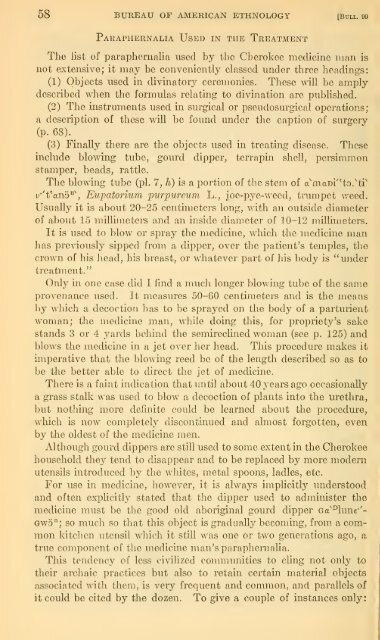Untitled - Smithsonian Institution
Untitled - Smithsonian Institution
Untitled - Smithsonian Institution
Create successful ePaper yourself
Turn your PDF publications into a flip-book with our unique Google optimized e-Paper software.
58 BUREAU OF AMERICAN ETHNOLOGY [Bull. 99<br />
Paraphernalia Used in the Treatment<br />
The list of paraphernalia used by the Cherokee medicine man is<br />
not extensive; it may be conveniently classed under three headings:<br />
(1) Objects used in divinatory ceremonies. These will be amply<br />
described when the formulas relating to divination are published.<br />
(2) The instruments used in surgical or pseudosurgical operations;<br />
a description of these will be found under the caption of surgery<br />
(p. 68)._<br />
(3) Finally there are the objects used in treating disease. These<br />
include blowing tube, gourd dipper, terrapin shell, persimmon<br />
stamper, beads, rattle.<br />
The blowing tube (pi. 7, h) is a portion of the stem of a'maDi"to.'ti'<br />
v't'ano°\ Eufatorium purpureum L., joe-pye-w^eed, trumpet weed.<br />
Usually it is about 20-25 centimeters long, with an outside diameter<br />
of about 15 millimeters and an inside diameter of 10-12 millimeters.<br />
It is used to blow or spray the medicine, w'hich the medicine man<br />
has previously sipped from a dipper, over the patient's temples, the<br />
crown of his head, his breast, or whatever part of his body is "under<br />
treatment."<br />
Only in one case did I find a much longer blowing tube of the same<br />
provenance used. It measures 50-60 centmieters and is the means<br />
by wiiich a decoction has to be sprayed on the body of a parturient<br />
woman; the medicine man, w^hile doing this, for propriety's sake<br />
stands 3 or 4 yards behind the semireclined woman (see p. 125) and<br />
blows the medicine in a jet over her head. This procedure makes it<br />
hnperative that the blowing reed be of the length described so as to<br />
be the better able to direct the jet of medicine.<br />
There is a faint indication that until about 40 years ago occasionally<br />
a grass stalk was used to blow a decoction of plants into the urethra,<br />
but nothing more definite could be learned about the procedure,<br />
w^hich is now completely discontinued and almost forgotten, even<br />
by the oldest of the medicine men.<br />
Although gourd dippers are still used to some extent in the Cherokee<br />
household they tend to disappear and to be replaced by more modern<br />
utensils introduced by the whites, metal spoons, ladles, etc.<br />
For use in medicine, however, it is always implicitly understood<br />
and often explicitly stated that the dipper used to administer the<br />
medicine must be the good old aboriginal gourd dipper Ga'^lune*'-<br />
Gwo°; so much so that this object is gradually becoming, from a common<br />
kitchen utensil which it still was one or two generations ago, a<br />
true component of the medicine man's paraphernalia.<br />
This tendency of less civilized connnunities to cling not only to<br />
their archaic practices but also to retain certain material objects<br />
associated with them, is very frequent and common, and parallels of<br />
it could be cited by the dozen. To give a couple of instances only:

















